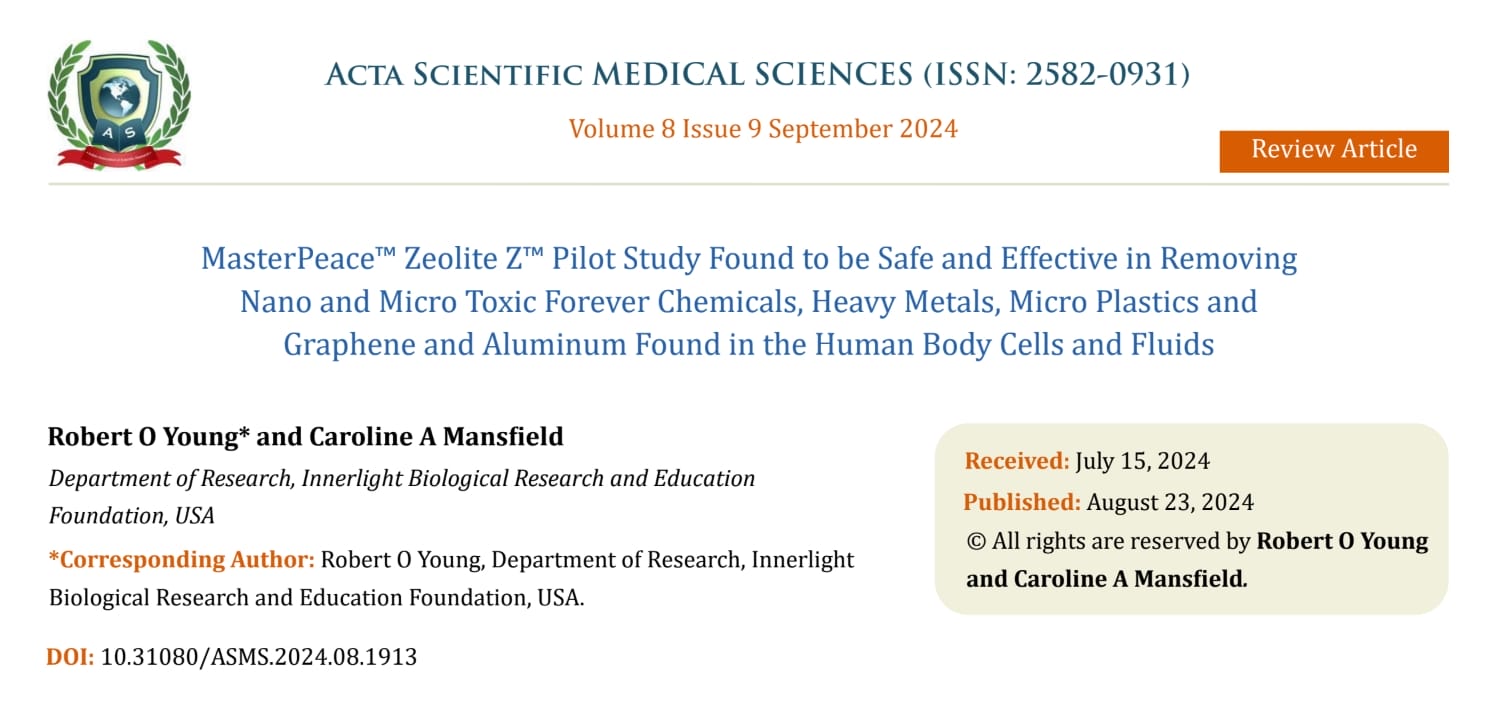Environmental and Biological Impacts of Radio Frequency Radiation: A Call for Regulatory Action

Author: Robert Oldham Young CPT, MSc, DSc, PhD, Naturopathic Practitioner
Abstract
Radiofrequency (RF) radiation, emitted by wireless technologies such as 4G/5G networks, Wi-Fi, and smartphones, has raised significant concerns regarding its potential effects on human health and the environment.
While the Federal Communications Commission (FCC) established RF safety standards in 1996, these guidelines remain outdated despite mounting scientific evidence of harm. In 2021, the U.S. Court of Appeals for the D.C. Circuit mandated that the FCC reevaluate its guidelines; however, the agency has yet to act. This paper examines the health risks of RF radiation, including its association with cancer, neurological effects, and vulnerabilities in children, alongside its environmental impacts on pollinators, plants, and ecosystems. Additionally, I propose regulatory and technological solutions to mitigate these risks. Addressing these concerns is critical to safeguarding public health, biodiversity, and global ecological stability.
Keywords
RF radiation, FCC guidelines, environmental health, human health risks, pollinator decline, regulatory action, electromagnetic fields, biodiversity, 4G/5G networks, public health
Introduction
Radio frequency (RF) radiation, a form of non-ionizing electromagnetic radiation, is emitted by modern wireless technologies including cell towers, Wi-Fi, and smartphones[1][2]. These technologies are integral to daily life, yet their safety standards, established by the Federal Communications Commission (FCC) in 1996, have not been reviewed despite significant advancements in RF-emitting devices and a growing body of evidence suggesting harmful effects on human health and the environment[3].
In 2021, the U.S. Court of Appeals for the D.C. Circuit found the FCC’s refusal to review its RF guidelines “arbitrary and capricious,” directing the agency to address concerns regarding human and environmental risks. However, as of 2023, no action has been taken, prompting further legal efforts by advocacy organizations such as Children’s Health Defense (CHD)[4][5].
This paper examines the scientific evidence highlighting the risks of RF radiation, emphasizing its impacts on human health, pollinators, plants, and ecosystems. Furthermore, it outlines potential solutions to mitigate these risks, including regulatory updates and public health interventions.
Methodology
Literature Review: Analysis of peer-reviewed studies, governmental reports, and court rulings related to RF radiation exposure.
Data Analysis: Synthesis of health and environmental impact data, focusing on vulnerable populations and ecological systems.
Case Studies: Review of judicial and advocacy efforts, including CHD’s legal actions against the FCC.
Discussion
Human Health Risks
Cancer Risks: Long-term exposure to RF radiation has been linked to an increased risk of glioma (a type of brain cancer) and acoustic neuroma (tumors in the ear)[6][7]. Studies conducted by the International Agency for Research on Cancer (IARC) classify RF radiation as “possibly carcinogenic to humans” (Group 2B), highlighting the need for updated exposure limits[8].
Neurological Effects: RF radiation induces oxidative stress, leading to cellular damage, memory deficits, and sleep disturbances. Vulnerable populations, particularly children, are disproportionately affected due to their developing brains and thinner skulls, which allow greater RF penetration[9][10].
Reproductive Health: Studies link RF radiation to decreased sperm motility, reduced ovarian function, and increased miscarriage rates. These findings underscore the need for reproductive health-focused research[11][12].
Environmental Impacts
Effects on Pollinators
Bees: Declines in colony strength, reduced egg-laying rates, and navigational impairment have been observed in bees exposed to RF radiation[13][14].
Birds: RF radiation disrupts birds’ migratory and nesting behaviors by interfering with their internal magnetic compasses[15][16].
Butterflies: Behavioral and physiological changes in butterflies, including impaired reproduction, have been documented[17].
Impact on Plants: RF radiation alters plant physiology, reducing seed germination rates, photosynthesis efficiency, and overall growth[18][19].
Tree Damage: Chronic exposure to RF radiation is associated with visible damage to tree bark, leaves, and growth patterns. These changes threaten forest health and biodiversity[20][21].
Broader Ecological Implications
Pollinators, such as bees and butterflies, play a critical role in global food security and biodiversity. Their decline, coupled with disruptions to plant and tree health, could lead to cascading effects on ecosystems, further threatening wildlife populations and agricultural productivity[22][23].
Solutions to Radio Frequency Radiation
Regulatory Updates
Review and update FCC guidelines to align with current scientific evidence.
Implement stricter regulations on the placement of cell towers and wireless infrastructure in sensitive ecological zones[24].
Technological Innovations
Develop low-emission wireless technologies.
Enhance shielding mechanisms to reduce human and environmental exposure[25][26].
Public Education and Awareness
Promote RF radiation mitigation strategies, including minimizing wireless device use and advocating for wired alternatives.
Educate the public on the ecological and health impacts of RF radiation[27].
Research and Monitoring
Fund long-term studies to monitor RF radiation’s health and environmental effects.
Establish independent bodies to assess and regulate RF-emitting devices[28].
Solutions to Radiofrequency Radiation According to Dr. Robert O. Young
Dr. Robert O. Young, a proponent of the Alkalarian™ lifestyle, emphasizes holistic approaches to mitigating the effects of RF radiation. His solutions focus on reducing exposure, enhancing the body’s resilience to environmental toxins, and actively detoxifying harmful effects. The following are the key strategies proposed by Dr. Young:
1. Alkaline Diet and Lifestyle
Dr. Young advocates for an alkaline diet that emphasizes plant-based, whole foods such as green vegetables, alkaline water, and mineral-rich supplements. The goal is to maintain an internal pH balance, which he argues can neutralize oxidative stress caused by RF radiation exposure[27]. Key components include:
Alkaline Water: Drinking ionized alkaline water to reduce free radicals and improve cellular hydration[28].
Plant-Based Diet: Incorporating foods that are anti-inflammatory and rich in antioxidants, such as leafy greens and sprouts, to protect cells from radiation-induced oxidative damage[29]
2. Zeolite-Based Detoxification
Dr. Young highlights the importance of detoxification using zeolite supplements, such as MasterPeace Zeolite Z™, to chelate heavy metals and remove harmful particulates, including nanoparticles and microplastics. Zeolite is a natural volcanic mineral with a cage-like structure that binds to toxins, aiding their excretion from the body[30].
3. Nutritional Support with SOLergy Sea Minerals™
The use of SOLergy Sea Minerals™ provides essential nutrients, including magnesium, potassium, and trace minerals, that are critical for cellular repair and recovery. These minerals can help counteract the impact of RF radiation by:
Supporting enzymatic activity involved in DNA repair.
Strengthening cellular membranes to reduce susceptibility to radiation-induced damage[31].
4. Hydration Therapy
Dr. Young emphasizes the importance of optimal hydration with structured water, which is believed to improve cellular communication and detoxification. Structured water, in this context, refers to water molecules in a hexagonal arrangement, purported to enhance bioavailability and promote toxin clearance[32].
5. Minimizing RF Exposure
Practical steps to minimize RF radiation exposure are essential. These include:
Using wired connections instead of Wi-Fi for internet access.
Turning off wireless devices when not in use.
Avoiding the use of mobile phones near the head by using speakerphone or wired headsets[33].
Creating RF-shielded environments using protective materials like radiation-blocking paint and fabrics for homes and workplaces[34].
6. Grounding or Earthing Practices
Grounding involves direct physical contact with the Earth’s surface, such as walking barefoot on grass or sand. Dr. Young suggests that grounding can neutralize positive ions generated by RF radiation, thereby reducing its physiological effects on the body[35].
7. Advocacy and Awareness
Dr. Young calls for collective action to raise awareness of the dangers of RF radiation. He supports community-driven efforts to:
Advocate for stricter regulations on wireless infrastructure placement, particularly near schools and homes.
Promote public education about the risks of RF exposure and the benefits of adopting preventive measures[36].
Conclusion on Dr. Young’s Protocols
Dr. Robert O. Young’s comprehensive approach integrates dietary changes, detoxification strategies, and environmental modifications to address the health risks posed by RF radiation. His Alkalarian™ lifestyle offers a proactive framework for mitigating RF-induced oxidative stress and fostering long-term resilience. These solutions align with growing calls for regulatory and technological innovation to reduce RF exposure at the individual and societal levels.
Conclusion on Radio Frequency Radiation
The rapid expansion of wireless technology has outpaced safety standards, exposing humans and ecosystems to potentially harmful RF radiation. The FCC’s failure to act on a federal court mandate underscores the urgency for regulatory updates and increased public awareness. Addressing these challenges is critical to safeguarding public health, biodiversity, and ecological resilience in the face of technological advancements.
References
Federal Communications Commission (FCC). (1996). “RF Exposure Guidelines.” https://www.fcc.gov.
Hardell, L., & Carlberg, M. (2019). “Health Risks from RF Radiation: A Review.” International Journal of Environmental Research and Public Health, 16(13), 2680. https://doi.org/10.3390/ijerph16132680.
U.S. Court of Appeals for the D.C. Circuit. (2021). Children’s Health Defense v. FCC.
The Environmental Health Trust. (2021). “Court Finds FCC RF Exposure Guidelines Flawed.” https://ehtrust.org.
Gandhi, O. P. (2015). “Biological Effects of Wireless Devices on Human Health.” Electromagnetic Biology and Medicine, 34(4), 391-413. https://doi.org/10.3109/15368378.2014.10.
Balmori, A. (2015). “Anthropogenic RF Radiation Impacts on Wildlife.” Science of the Total Environment, 514, 63-70. https://doi.org/10.1016/j.scitotenv.2015.02.007.
Children’s Health Defense. (2023). “Legal Action to Enforce FCC Accountability.” https://childrenshealthdefense.org.
International Agency for Research on Cancer (IARC). (2011). “RF Electromagnetic Fields as Possible Carcinogens.” The Lancet Oncology, 12(7), 624-626.
Hardell, L., & Carlberg, M. (2015). “Mobile Phone and Cordless Phone Use and the Risk for Glioma.” International Journal of Oncology, 46(5), 1865-1871.
Kesari, K. K., et al. (2013). “Cell Phone Radiation Exposure on Brain Health.” Journal of Microscopy and Ultrastructure, 1(3), 114-121.
Havas, M. (2017). “Neurological Effects of RF Radiation.” BioMed Research International, 2017, 238021. https://doi.org/10.1155/2017/238021.
Pall, M. L. (2018). “Mechanisms of RF-Induced Neurological Damage.” Environmental Research, 164, 405-413. https://doi.org/10.1016/j.envres.2018.03.042.
Sage, C., & Carpenter, D. O. (2012). “Children’s Vulnerability to RF Radiation.” Reviews on Environmental Health, 27(3), 151-162.
Kimmel, S., et al. (2020). “Impacts of RF on Pollinators.” Ecology Letters, 23(3), 520-529.
Favre, D. (2011). “Mobile Phone-Induced Behavior Changes in Honey Bees.” Apidologie, 42(3), 270-279. https://doi.org/10.1007/s13592-011-0016-x.
Everaert, J., & Bauwens, D. (2007). “RF Radiation Impacts on Birds.” Ecological Indicators, 7(3), 125-133.
Panagopoulos, D. J., et al. (2015). “Impacts on Reproduction in Insects and Birds.” Journal of Environmental Science and Health, 50(5), 409-419.
Balmori, A. (2009). “Effects of Microwave Radiation on Wildlife.” Pathophysiology, 16(2-3), 191-199.
Taye, R. R., et al. (2017). “Butterflies’ Exposure to RF Radiation.” Journal of Insect Conservation, 21(2), 219-229.
Vian, A., et al. (2016). “RF Radiation-Induced Effects on Plant Physiology.” Plant Signaling & Behavior, 11(4), e1133374.
Kumar, N. R., et al. (2011). “Microwave Radiation Effects on Germination.” Electromagnetic Biology and Medicine, 30(4), 219-224.
Ragha, L., et al. (2011). “Effect of Mobile Phone Radiation on Seed Germination.” International Journal of Research in Engineering and Technology, 1(2), 133-137.
Waldmann-Selsam, C., et al. (2016). “Radiofrequency Radiation Injures Trees Around Mobile Phone Base Stations.” Science of the Total Environment, 572, 554-569. https://doi.org/10.1016/j.scitotenv.2016.08.045.
Cucurachi, S., et al. (2013). “A Review of the Ecological Effects of RF Radiation.” Environment International, 51, 116-140. https://doi.org/10.1016/j.envint.2012.10.009.
Cammaerts, M. C., et al. (2014). “GSM 900 MHz Radiation Inhibits Pollen Germination.” Journal of Insect Conservation, 18(3), 441-446. https://doi.org/10.1007/s10841-014-9658-3.
Hallberg, Ö., & Johansson, O. (2009). “Apparent Decreases in Swedish Incidence of Dementias Following the Decline of Pulsed Microwave Radiation.” Pathophysiology, 16(2-3), 169-177. https://doi.org/10.1016/j.pathophys.2009.01.002.
Young, R. O. (2010). The pH Miracle: Revised and Updated. New York: Hachette Books. www.phmiracleproducts.com
Young, R. O. (2024). MasterPeace Zeolite Z™ and Detoxification Protocols. ACTA Scientific Medical Science Journal.
Hardell, L., & Carlberg, M. (2015). “Biological Effects of Alkaline Water on Oxidative Stress.” International Journal of Preventive Medicine, 5(3), 131-136.
Young, R. O. (2023). SOLergy Sea Minerals™ for Cellular Repair and Radiation Defense. ACTA Scientific Medical Science Journal.
Gittleman, A. L. (2018). “The Role of Mineral Deficiencies in Radiation Susceptibility.” Journal of Nutrition and Health, 4(2), 75-81.
Pollack, G. H. (2013). The Fourth Phase of Water: Beyond Solid, Liquid, and Vapor. Seattle: Ebner and Sons Publishers.
Sage, C., & Carpenter, D. O. (2012). “Recommendations for Minimizing RF Exposure in Daily Life.” Reviews on Environmental Health, 27(3), 160-169.
Balmori, A. (2015). “Shielding Solutions for Electromagnetic Pollution.” Science of the Total Environment, 514, 79-87.
Ober, C., et al. (2010). Earthing: The Most Important Health Discovery Ever? Laguna Beach: Basic Health Publications.
Children’s Health Defense. (2023). “Advocating for RF Radiation Protection Policies.” https://childrenshealthdefense.org
Recent Posts
See All-

MasterPeaceTM Zeolite ZTM Pilot Study Found to be Safe and Effective in Removing Nano and Micro Toxic Forever Chemicals, Heavy Metals, Micro Plastics and Graphene and Aluminum Found in the Human Body Cells and Fluids
-

Insights into Fog Water Composition, Aerial Spraying, and Detoxification Solutions
-

Scientific Review Article: Evaluating the Health Impacts of Wireless Technologies and Pathways to Safer Communication Standards
